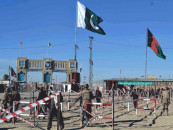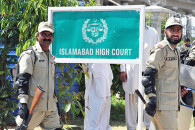Nightmare ends: Flights resume after 16-hour horror
Fatalities put at 29, at least 6 aircraft damaged after successful 5-hour operation.

Troops take position with an armored vehicle at the Karachi airport terminal after the militants' assault in Karachi on June 8, 2014. PHOTO: AFP
After a 16-hour ordeal, military convoys exited Pakistan’s busiest Jinnah International Airport after handing control back to the Civil Aviation Authority (CAA) and the Airport Security Force (ASF) by 5pm. “Flight operations resumed at the airport at 4pm with the first flight departing for Islamabad,” said a senior CAA spokesperson.
A total of 29 people, including 10 terrorists, 11 ASF personnel, one each of the police, Rangers and Shaheen Air International and one unknown, were killed. Twenty-six others have been injured in the brazen assault.
“The Elite Force, Special Security Unit and the district police assisted the security and paramilitary forces in hunting down the militants,” said AIG Ghulam Qadir Thebo, the Karachi police chief. “All possible counterterrorism techniques were quickly discussed, jobs assigned, backup called and the operation executed.”
Rangers DG Maj-Gen Rizwan Akhtar, while lauding the bravery of security forces, announced that all the 10 terrorists were killed in the successful operation. The attackers were aged between 20 to 25 years and were apparently foreign nationals. “Seven terrorists were killed by security forces while three blew themselves up,” he explained.
“All aircraft have been checked and none of them have been damaged,” he claimed, which contradicted eyewitness accounts. Quoting initial reports, he indicated foreign involvement in the terrorist act.
What happened?
Five of the 10 militants – equipped with suicide vests and automatic weapons – managed to enter the main Fokker gate that leads to the maintenance facility where aircraft are overhauled. As soon as they reached the maintenance and aircraft hangar, a huge explosion took place, which marked the first suicide bombing.
The militants were divided into two groups: each comprising at least five members. Moments after the first group of militants attacked the Fokker gate, the second group tried to enter the runway premises through the VIP gate located next to the CAA headquarters. However, the terrorists moved towards the Cargo area adjacent to the Hajj Terminal.
“They entered the Cargo area through the office of the Immediate Clearance Group of the Pakistan Customs,” said a clearing agent, Zahid Ahmed. “There, they killed two more ASF guards, bombed the Gerry’s D’nata cargo station and damaged two to three planes.”
“The terrorists also operated in pairs. That’s why their bodies were found lying in pairs,” explained senior police officer Raja Umar Khattab. He added that the militants had fired rockets at passenger planes but missed. “It seems there was some ill-planning on their part.”
At least six aircraft, including a PIA Boeing 747, were damaged, according to officials, as they fell in the range of the hail of bullets. Jet fuel-storage tanks also caught fire but fire fighters were able to control the blaze before more damaged could be done. Officials were not immediately able to estimate the financial loss caused by attack.
Security forces claim to have recovered three suicide jackets, two rockets with launchers, 19 rifles, 16 hand grenades, 12 petrol bombs as well as cell phones. Some anticoagulants injections were also seized. One rifle was apparently Indian-made, but investigations regarding the supply of the arsenal are under way.
No case has been registered as yet.
Published in The Express Tribune, June 10th, 2014.



















COMMENTS
Comments are moderated and generally will be posted if they are on-topic and not abusive.
For more information, please see our Comments FAQ